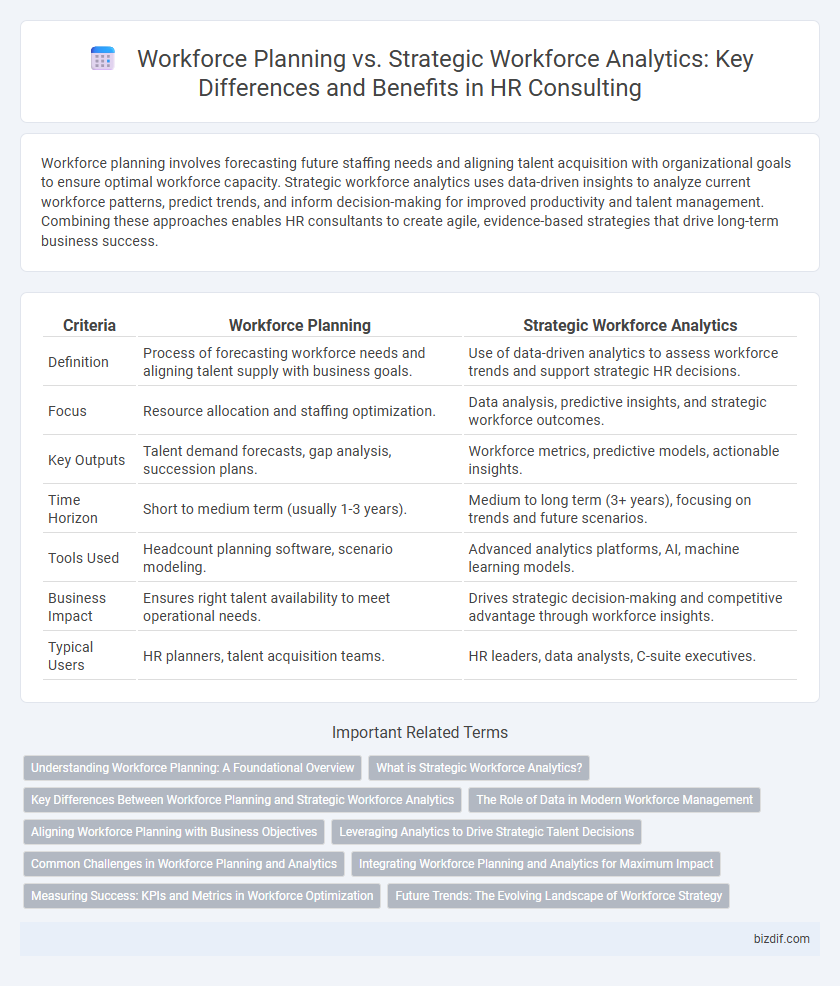Workforce planning involves forecasting future staffing needs and aligning talent acquisition with organizational goals to ensure optimal workforce capacity. Strategic workforce analytics uses data-driven insights to analyze current workforce patterns, predict trends, and inform decision-making for improved productivity and talent management. Combining these approaches enables HR consultants to create agile, evidence-based strategies that drive long-term business success.
Table of Comparison
| Criteria | Workforce Planning | Strategic Workforce Analytics |
|---|---|---|
| Definition | Process of forecasting workforce needs and aligning talent supply with business goals. | Use of data-driven analytics to assess workforce trends and support strategic HR decisions. |
| Focus | Resource allocation and staffing optimization. | Data analysis, predictive insights, and strategic workforce outcomes. |
| Key Outputs | Talent demand forecasts, gap analysis, succession plans. | Workforce metrics, predictive models, actionable insights. |
| Time Horizon | Short to medium term (usually 1-3 years). | Medium to long term (3+ years), focusing on trends and future scenarios. |
| Tools Used | Headcount planning software, scenario modeling. | Advanced analytics platforms, AI, machine learning models. |
| Business Impact | Ensures right talent availability to meet operational needs. | Drives strategic decision-making and competitive advantage through workforce insights. |
| Typical Users | HR planners, talent acquisition teams. | HR leaders, data analysts, C-suite executives. |
Understanding Workforce Planning: A Foundational Overview
Workforce planning involves forecasting future talent needs and aligning them with organizational goals to optimize employee deployment and minimize skill gaps. It establishes a structured process for identifying workforce requirements based on business objectives, market trends, and internal capabilities. Strategic workforce analytics enhances this by leveraging data-driven insights to refine planning accuracy and support proactive decision-making.
What is Strategic Workforce Analytics?
Strategic Workforce Analytics is the use of data-driven insights to align workforce capabilities with long-term business goals, enabling informed decision-making and predictive modeling. It involves analyzing employee performance, skills gaps, and labor market trends to optimize talent acquisition, development, and retention strategies. Unlike traditional workforce planning, it integrates advanced analytics and technology to forecast future workforce needs and drive organizational agility.
Key Differences Between Workforce Planning and Strategic Workforce Analytics
Workforce Planning focuses on forecasting future staffing needs and aligning talent acquisition with organizational goals, emphasizing headcount, skills requirements, and timelines. Strategic Workforce Analytics involves analyzing workforce data trends, productivity metrics, and employee performance to drive data-driven decisions and optimize workforce strategies. The key difference lies in Workforce Planning's proactive approach to resource allocation, while Strategic Workforce Analytics provides actionable insights through advanced data analysis.
The Role of Data in Modern Workforce Management
Workforce Planning leverages historical and current employee data to forecast staffing needs and align resources with business goals. Strategic Workforce Analytics utilizes advanced data modeling and predictive analytics to provide deeper insights into workforce trends, enabling proactive decision-making. Data-driven approaches transform modern workforce management by enhancing accuracy, efficiency, and strategic alignment in talent acquisition and retention processes.
Aligning Workforce Planning with Business Objectives
Workforce planning involves forecasting labor needs to ensure the right talent is in place, while strategic workforce analytics uses data-driven insights to align workforce strategies with business objectives. By integrating strategic workforce analytics, HR professionals can identify skill gaps, optimize talent allocation, and anticipate future workforce trends that support organizational goals. This alignment enhances decision-making, improves talent retention, and drives business performance through targeted workforce investments.
Leveraging Analytics to Drive Strategic Talent Decisions
Workforce planning uses data to forecast future talent needs and align staffing with business objectives, while strategic workforce analytics dives deeper into analyzing patterns and trends to identify skill gaps and optimize talent management. Leveraging advanced analytics enables organizations to make informed, proactive decisions about recruitment, development, and retention strategies. Integrating these approaches empowers HR leaders to drive strategic talent decisions that enhance workforce agility and business performance.
Common Challenges in Workforce Planning and Analytics
Common challenges in workforce planning and strategic workforce analytics include data integration issues, where disparate HR systems and data silos prevent accurate insights. Limited analytical skills within HR teams hinder the effective interpretation of complex workforce data, affecting decision-making. Forecasting accuracy is often compromised by rapidly changing market conditions and workforce dynamics, making long-term planning difficult.
Integrating Workforce Planning and Analytics for Maximum Impact
Integrating workforce planning with strategic workforce analytics leverages data-driven insights to optimize talent acquisition, retention, and development strategies. By combining predictive analytics with workforce planning, organizations can anticipate skill gaps, forecast labor demands, and align human capital investments with business objectives. This fusion enhances decision-making accuracy, driving operational efficiency and competitive advantage in dynamic market environments.
Measuring Success: KPIs and Metrics in Workforce Optimization
Effective workforce optimization relies on precise KPIs such as employee productivity rates, turnover ratios, and skill gap analyses to measure success in both Workforce Planning and Strategic Workforce Analytics. Workforce Planning emphasizes forecasting labor needs and assessing recruitment effectiveness, while Strategic Workforce Analytics leverages data-driven insights to optimize talent allocation and predict future workforce trends. Combining these metrics enhances decision-making, reduces costs, and drives organizational agility in HR management.
Future Trends: The Evolving Landscape of Workforce Strategy
Workforce planning and strategic workforce analytics are converging to drive proactive talent management by leveraging AI-driven predictive models and real-time labor market data. Emerging trends emphasize integrating advanced analytics with scenario-based planning to anticipate skill gaps, optimize workforce agility, and align talent strategies with dynamic business objectives. Organizations adopting these future-ready approaches can enhance decision-making accuracy, reduce turnover, and sustain competitive advantage in a rapidly evolving workforce landscape.
Workforce Planning vs Strategic Workforce Analytics Infographic

 bizdif.com
bizdif.com